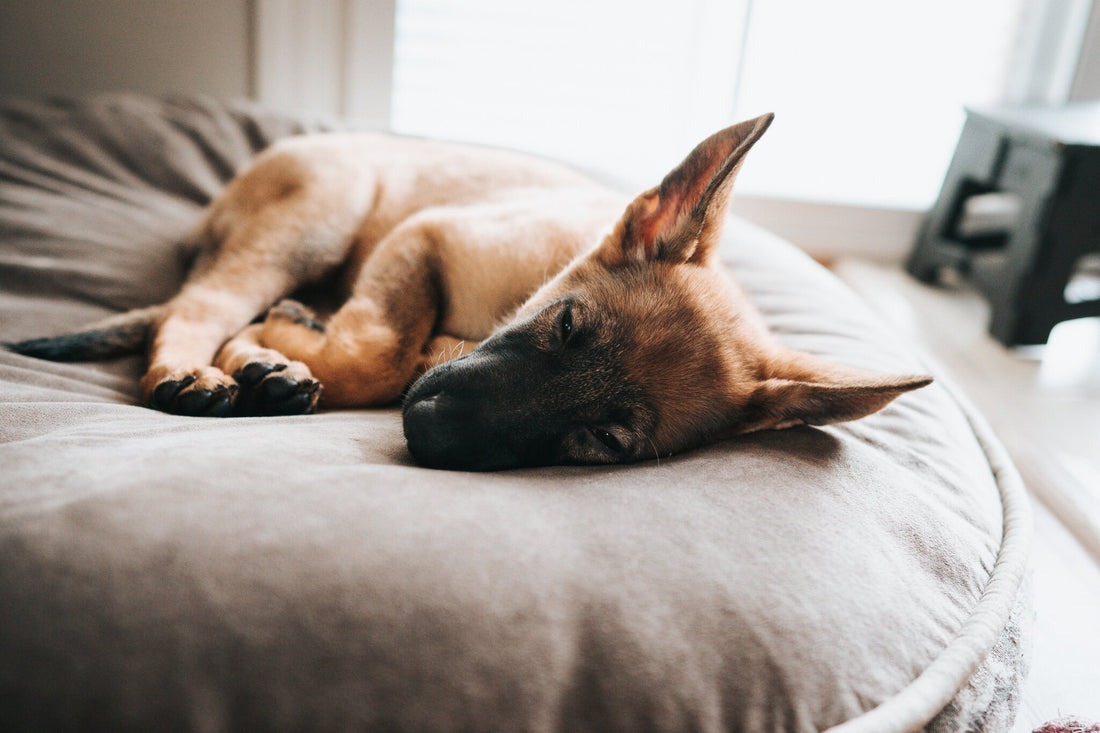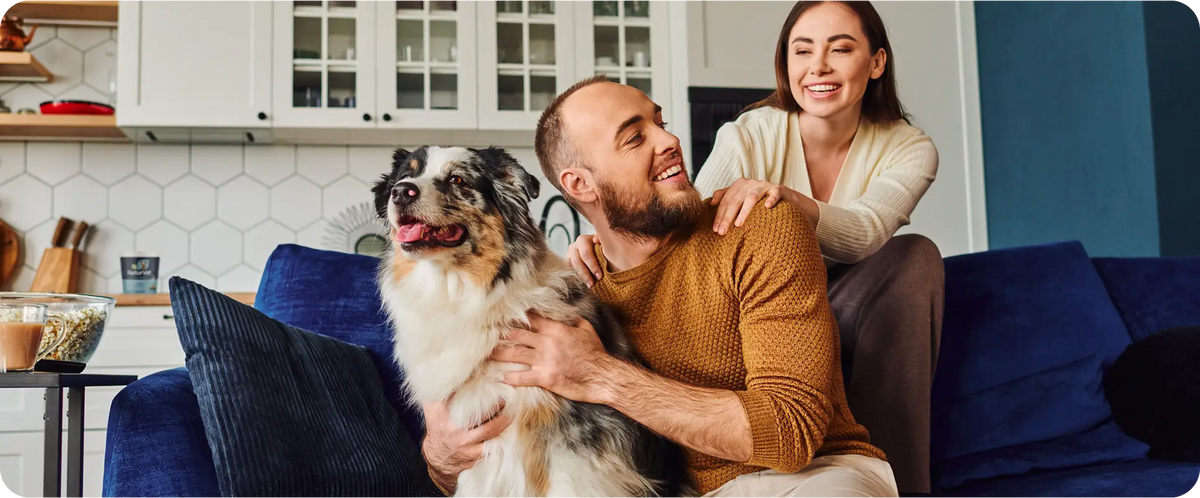Dog Sleeping Positions: What They Mean
You probably don't think about your dog's sleeping habits very often. You're likely more concerned with whether or not your best friend is getting enough exercise or what kind of food to feed them.
But have you ever considered that your dog’s sleeping habits can tell you a TON about his mood and state of health? It's true! And it's not just a matter of whether or not he's snoring—it's a matter of how often he sleeps, where he sleeps, and what other behaviors are associated with his sleep patterns.
Today, we'll look at some common sleeping positions and habits in dogs and how they can give clues about what's happening in your dog’s mind and life.

Common Canine Sleeping Positions
Sleeping dogs lie, but they all have their unique way of doing it.
The sleeping position is a reflection of your dog's personality and lifestyle. Some dogs are laid-back and relaxed, while others are active and lively. Your dog's sleeping position can also indicate whether your dog is comfortable with people or not.
If you want to know how to read your dog's body language and better understand why they're sleeping in certain positions, then check out these typical dog sleeping positions and their meanings below:
Curled Up In A Ball

Dogs curl up in a ball when they want to be safe from harm or feel insecure or anxious about their surroundings. This position makes it easier for them to protect themselves from predators and other dangers in their environment. Dogs will often curl up in this way when they’re trying to sleep and when resting in general. They may also roll into this position if there happens to be something uncomfortable beneath them or if they simply feel like curling up!
Sleeping On Their Side

Sleeping on the side is an excellent way for a dog to get some shut-eye. It's comfortable, leaves them free to move and twitch in their sleep, and exposes their vital organs—an indicator that they feel safe and secure. Dogs who sleep in this position tend to be relaxed, but they may switch up their position if they're sleeping somewhere new or around someone unfamiliar.
The “Superman” – Sprawled Out On The Tummy

The classic sleeping position for many dogs is typically for very relaxed dogs who feel safe in their environment. It's common for puppies to sleep this way because their bones and joints aren't fully grown yet, and they can't curl up into a ball. Some adult dogs occasionally use this position if they feel exceptionally comfortable or just want to get as much of their body off the ground as possible!
Buried In Toys

When your dog slips into a deep, snoring sleep buried in his favorite toys, he may be trying to tell you something! It's not that he doesn't love you; but rather, that he appreciates the comfortable home you’ve provided him. And if he’s snuggled up in a pile of soft and cuddly plush toys that smell just like you, then all the better!
Paws Up In The Air

When your dog is lying down with his paws in the air, it means he’s completely relaxed. If he’s sleeping this way when they're asleep and doesn’t wake up when someone comes into the room, it’s safe to assume that his mind is at ease and isn’t preoccupied with anything at all—just pure relaxation!
Back-To-Back Or Snuggled Up

You know how you feel when you're lying in bed and want to wrap yourself up in a giant blanket? Dogs love that feeling, too!
Many dogs prefer to sleep back-to-back with other pets or people because it helps them feel safe and protected. This is especially true for dogs who suffer from anxiety, fear, and loneliness. When a dog feels stressed or threatened, he often looks for somewhere safe to sleep — which could mean curling up next to another pet or person to feel secure.
Sleeping Behaviors Explained
Unfortunately, you can’t just ask your dog how he slept or what he dreamt about. Instead, you have to read his body language and behavior while sleeping. Here are some common doggo sleeping behaviors, along with what they mean:
Agitation and Whimpering
If your dog is restless, whining, barking more than usual, and seems anxious, he may be experiencing a nightmare. You can try to calm him down by petting his back gently while whispering comforting words in his ear. So if your dog struggles with sleep anxiety, try comforting him by petting and talking to him before he falls asleep. If this doesn't help, you may want to consult a vet about his symptoms.
However, if you notice that your dog is struggling with nightmares regularly, it could signify depression or anxiety. These issues can be treated with medication and behavioral therapy, so if your dog seems more sad or stressed than usual during the day, it's worth taking him in to see the vet.
Light Dozing
Light dozing is a state of sleep that's not quite deep enough to count as REM, but it's still deeper than normal wakefulness. It's the kind of sleep you can easily slip into after a long day and just as easily slip out of when your dog hears something interesting outside his window.
When you see your dog lying down with his eyes partially closed and his head tilted to one side, he's probably in light doze mode. Dogs don't dream in this state—they just rest their brains for a minute or two before waking up fully.
Digging and Circling
Dogs like to ensure their sleeping area is as cozy as possible. This means they will often circle their bed a few times before lying down. The first purpose of this position is to keep them warm in the winter and cool in the summer (which is why you should never let your dog sleep on the floor). Second, it helps them feel safe and secure by allowing them to check out the area from all angles.
But what if you notice that your dog is circling more than usual or has trouble settling down? It may signify arthritis or neurological issues such as vestibular disease, affecting balance and coordination. So look out for these signs and consult a vet if you notice excessive circling!
Excessive Twitching
If your dog seems to be twitching and moving around in his sleep more than usual, it could mean he's having a seizure. So, if you see your pup shaking or stiffening up while he's asleep, give him a gentle nudge to see if he wakes up on his own—if so, then it was probably just a dream (and perhaps a nightmare). But if he seems unable to wake up or respond when you call his name, that's a sign that something's wrong, and take him to the vet as soon as possible.
Tail Wagging, Twitching, or Barking Softly
This kind of movement is common during REM sleep, which happens when your dog has achieved deep sleep. It happens more frequently in puppies and elderly dogs because they tend to move more frequently during sleep than adult dogs.
It could also signify that he's feeling cold or uncomfortable in his bedding. Check his room's temperature and ensure he has plenty of blankets and pillows for warmth!
Concluding Thoughts
Sleep is critical to every animal’s health and well-being, and your dog is no different! Ultimately, paying attention to his sleeping habits and behavior can help to inform you on how to better care for your best friend. While there are many potential explanations for the behaviors explored above, do not hesitate to reach out to your veterinarian with any concerns regarding your pet’s sleep or resting routines.
JOIN OUR PACK
Follow us @NaturVet on social media to fill us in on any tips we might have missed. And, check out the rest of NaturVet.com. We’ll keep you up to date on all our latest pet resources, supplements, tips and tricks, and more – everything you need to be the best pet parent possible.























